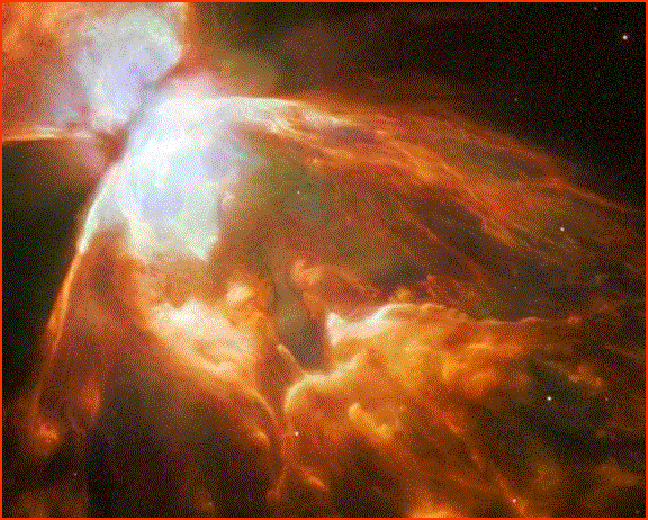
home •
about •
essential guide •
picture of the day •
thunderblogs •
news •
multimedia •
predictions •
products •
get involved •
contact
picture of the day archive subject index
Credit: A. Zijlstra (UMIST) et al., ESA, NASA
Oct 30, 2006
NGC 6302: Bug NebulaA hundred years ago astronomers assumed that any body larger than an asteroid would be constrained by gravity to a spherical shape. But as telescopes got better, reality intruded.
Planetary nebulae in particular, now thought to be the final explosive stage of large stars, fail to live up to spherical expectations. Over 60 years ago, Dr Charles Bruce, of the Electrical Research Association in England, began to note the similarities between planetary nebulae and electrical discharge phenomena. In this Hubble Telescope image of the planetary nebula known as the Bug Nebula, you can see many examples of these electrical characteristics. The overall shape is an hourglass, not a sphere. The central star is hidden by a dark dust torus. The light of the star is rich in ultraviolet, one of the signatures of electric discharge. And the shapes within the nebula mimic the twisted filaments, spirals and pillars typical of electrical discharge in plasmas.
Plasmas in the lab form cellular structures separated by thin layers of opposite charge called double layers. Does the same thing happen in nebulas? That's a tough question to answer, because the only known way detect a double layer is to send a probe through it, and nebulas are far beyond the reach of our spacecraft. But everywhere we've sent probes in our solar system, we've found cellular structures separated by double layers, just as we found in the plasma lab. We call these structures magnetospheres, magnetotails, bow shocks, comet heads and tails.
Hannes Alfvιn says, "... it is unpleasant to base far-reaching conclusions on the existence of a structure which we cannot detect directly. But the alternative is to draw far-reaching conclusions from the assumption that in distant regions, the plasmas have properties which are drastically different from what they are in our own neighborhood. This is obviously far more unpleasant ... " Although the answers are not yet known, Electric Universe researchers begin by assuming that the behavior of plasma will be the same whether you encounter it in the plasma lab or in a far-away stellar formation like the Bug Nebula. And that assumption offers a whole new viewpoint for the universe we live in.
___________________________________________________________________________Please visit our Forum
The Electric Sky and The Electric Universe available now!

|
|

|
EXECUTIVE EDITORS:
David Talbott, Wallace Thornhill
MANAGING EDITORS:
Steve Smith, Mel Acheson
CONTRIBUTING EDITORS: Dwardu Cardona, Ev Cochrane,
C.J. Ransom, Don Scott, Rens van der Sluijs, Ian Tresman
WEBMASTER: Brian Talbott
Copyright 2006: thunderbolts.info
![]()
home
thunderblogs
forum
picture of the day
resources
team
updates
contact us

